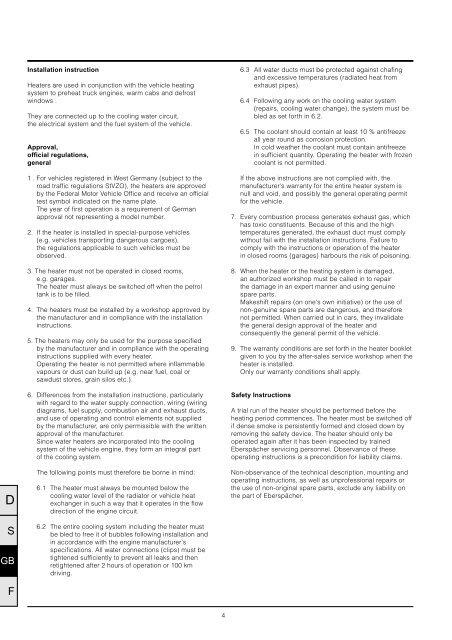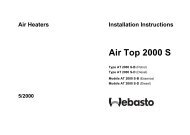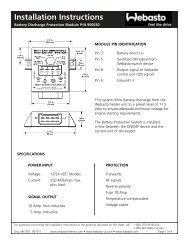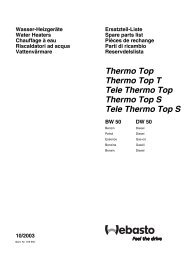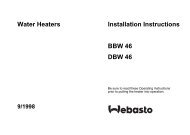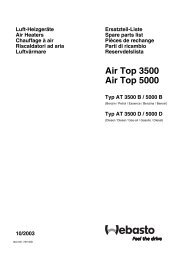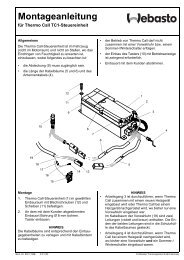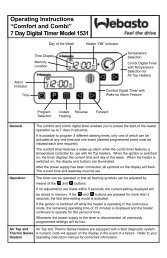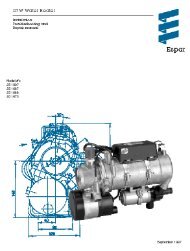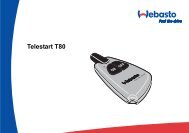HYDRONIC 10.pdf - VW-Bus-T4.de
HYDRONIC 10.pdf - VW-Bus-T4.de
HYDRONIC 10.pdf - VW-Bus-T4.de
Create successful ePaper yourself
Turn your PDF publications into a flip-book with our unique Google optimized e-Paper software.
D<br />
S<br />
GB<br />
F<br />
Installation instruction<br />
Heaters are used in conjunction with the vehicle heating<br />
system to preheat truck engines, warm cabs and defrost<br />
windows .<br />
They are connected up to the cooling water circuit,<br />
the electrical system and the fuel system of the vehicle.<br />
Approval,<br />
official regulations,<br />
general<br />
1 . For vehicles registered in West Germany (subject to the<br />
road traffic regulations StVZO), the heaters are approved<br />
by the Federal Motor Vehicle Office and receive an official<br />
test symbol indicated on the name plate.<br />
The year of first operation is a requirement of German<br />
approval not representing a model number.<br />
2. If the heater is installed in special-purpose vehicles<br />
(e.g. vehicles transporting dangerous cargoes),<br />
the regulations applicable to such vehicles must be<br />
observed.<br />
3. The heater must not be operated in closed rooms,<br />
e.g. garages.<br />
The heater must always be switched off when the petrol<br />
tank is to be filled.<br />
4. The heaters must be installed by a workshop approved by<br />
the manufacturer and in compliance with the installation<br />
instructions.<br />
5. The heaters may only be used for the purpose specified<br />
by the manufacturer and in compliance with the operating<br />
instructions supplied with every heater.<br />
Operating the heater is not permitted where inflammable<br />
vapours or dust can build up (e.g. near fuel, coal or<br />
sawdust stores, grain silos etc.).<br />
6. Differences from the installation instructions, particularly<br />
with regard to the water supply connection, wiring (wiring<br />
diagrams, fuel supply, combustion air and exhaust ducts,<br />
and use of operating and control elements not supplied<br />
by the manufacturer, are only permissible with the written<br />
approval of the manufacturer.<br />
Since water heaters are incorporated into the cooling<br />
system of the vehicle engine, they form an integral part<br />
of the cooling system.<br />
The following points must therefore be borne in mind:<br />
6.1 The heater must always be mounted below the<br />
cooling water level of the radiator or vehicle heat<br />
exchanger in such a way that it operates in the flow<br />
direction of the engine circuit.<br />
6.2 The entire cooling system including the heater must<br />
be bled to free it of bubbles following installation and<br />
in accordance with the engine manufacturer's<br />
specifications. All water connections (clips) must be<br />
tightened sufficiently to prevent all leaks and then<br />
retightened after 2 hours of operation or 100 km<br />
driving.<br />
6.3 All water ducts must be protected against chafing<br />
and excessive temperatures (radiated heat from<br />
exhaust pipes).<br />
6.4 Following any work on the cooling water system<br />
(repairs, cooling water change), the system must be<br />
bled as set forth in 6.2.<br />
6.5 The coolant should contain at least 10 % antifreeze<br />
all year round as corrosion protection.<br />
In cold weather the coolant must contain antifreeze<br />
in sufficient quantity. Operating the heater with frozen<br />
coolant is not permitted.<br />
If the above instructions are not complied with, the<br />
manufacturer's warranty for the entire heater system is<br />
null and void, and possibly the general operating permit<br />
for the vehicle.<br />
7. Every combustion process generates exhaust gas, which<br />
has toxic constituents. Because of this and the high<br />
temperatures generated, the exhaust duct must comply<br />
without fail with the installation instructions. Failure to<br />
comply with the instructions or operation of the heater<br />
in closed rooms (garages) harbours the risk of poisoning.<br />
8. When the heater or the heating system is damaged,<br />
an authorized workshop must be called in to repair<br />
the damage in an expert manner and using genuine<br />
spare parts.<br />
Makeshift repairs (on one's own initiative) or the use of<br />
non-genuine spare parts are dangerous, and therefore<br />
not permitted. When carried out in cars, they invalidate<br />
the general design approval of the heater and<br />
consequently the general permit of the vehicle.<br />
9. The warranty conditions are set forth in the heater booklet<br />
given to you by the after-sales service workshop when the<br />
heater is installed.<br />
Only our warranty conditions shall apply.<br />
Safety Instructions<br />
A trial run of the heater should be performed before the<br />
heating period commences. The heater must be switched off<br />
if dense smoke is persistently formed and closed down by<br />
removing the safety device. The heater should only be<br />
operated again after it has been inspected by trained<br />
Eberspächer servicing personnel. Observance of these<br />
operating instructions is a precondition for liability claims.<br />
Non-observance of the technical description, mounting and<br />
operating instructions, as well as unprofessional repairs or<br />
the use of non-original spare parts, exclude any liability on<br />
the part of Eberspächer.<br />
4


